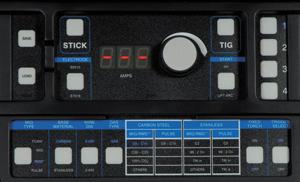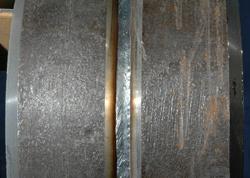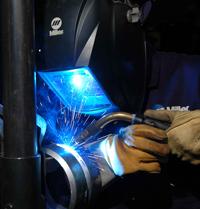Contributing Writer
- FMA
- The Fabricator
- FABTECH
- Canadian Metalworking
Categories
- Additive Manufacturing
- Aluminum Welding
- Arc Welding
- Assembly and Joining
- Automation and Robotics
- Bending and Forming
- Consumables
- Cutting and Weld Prep
- Electric Vehicles
- En Español
- Finishing
- Hydroforming
- Laser Cutting
- Laser Welding
- Machining
- Manufacturing Software
- Materials Handling
- Metals/Materials
- Oxyfuel Cutting
- Plasma Cutting
- Power Tools
- Punching and Other Holemaking
- Roll Forming
- Safety
- Sawing
- Shearing
- Shop Management
- Testing and Measuring
- Tube and Pipe Fabrication
- Tube and Pipe Production
- Waterjet Cutting
Industry Directory
Webcasts
Podcasts
FAB 40
Advertise
Subscribe
Account Login
Search
One size does not fit all
Application needs drive welding system development
- By Nick Peterson
- November 24, 2009
- Article
- Arc Welding

Figure 1: Push-button process selection potentially saves pipe fabrication shops $13,000 per year by reducing changeover time.
Unless you're that exceptional standard-sized person, chances are that one-size-fits-all clothing requires compromises. While tight gloves pinch, and a hat that's too big looks goofy, the consequences of choosing a one-size-fits-all welding system are much more serious. In today's economy, choosing the right system can be the crucial difference that keeps your doors open. And when the turnaround comes, it can be the difference that enables your company to capitalize quickly. The wrong choice might have you fighting for table scraps.
The welding industry historically has been slow to change, especially when it comes to adopting new technology. Too many fabricators and manufacturers have attempted to shoehorn a one-size-fits-all machine into every conceivable application. Sometimes a machine that does it all may not be the best answer; an optimized solution may be more beneficial.
The one-size-fits-all mentality has allowed significant waste (especially in the kaizen/lean/Six Sigma sense of the word) to creep into many operations. Spatter, burn-through, warping, poor part fit-up, overwelding, weld defects, poor first-pass yield, excessive grinding/polishing, and time wasted on consumables and process changeovers are just a few of the symptoms of waste that cost the industry millions of dollars in lost productivity every day (Figure 1).
The good news is that equipment manufacturers are doing a better job of truly understanding the needs of different applications, and fabricators are beginning to understand that sometimes systems with low initial costs can be long-term financial disasters. Here are some examples of innovations spawned by this new understanding.
Keep It Simple for Pipe Fabrication
Everyone knows shielded metal arc welding (SMAW) is slow, and gas tungsten arc welding (GTAW) is slower, but some pipe fabrication specifications simply don't allow you to substitute the faster gas metal arc welding (GMAW) or flux-cored arc welding (FCAW) processes. Of course, pipe fabricators work on dozens or hundreds of different projects a year, many of which do permit wire welding processes. These include short-circuit GMAW and FCAW (generally using a 75/25 argon/CO2 mix) and pulsed GMAW (which typically requires a 90/10 or 85/15 argon/CO2 mix).
So what should a pipe fabricator do? Cram a welding cell full of different equipment and consumables and waste an excessive amount of time on process changeover? Until recently, such a tactic was considered normal.
After interviewing many pipe fabricators, an equipment supplier determined that the features users value most aren't advanced welding processes, but simplicity. This led to the development of a pipe welding system that offers push-button process changeover (Figure 2) between every process used for welding steel and alloy pipe: GTAW, SMAW, standard GMAW, FCAW, and pulsed GMAW. The system eliminated the need to manually change polarity, swap out leads, or change gases.
Along with product simplicity, pipe fabricators said they wanted process simplicity. Unfortunately, training a welder to make code-quality SMAW and GTAW welds typically takes weeks, if not several months. While equipment can be simple, these are not simple processes to learn; they take great skill. Advanced GMAW pipe processes simplify and speed the learning process. Depending on experience, a welder can learn the processes in a matter of hours or a couple of days (Figure 3).
The advanced processes are cooler (both thermally and technologically) and slightly slower, which makes it easier for the operator to manipulate and control the weld puddle, which can improve weld quality, reduce rejection rates, and increase output per operator. Pulsed GMAW for pipe welding also has a focused arc cone and lower average current, which allows it to be used on pipe joints with V-grooves and out-of-position applications. The process exceeds the deposition rates of stick and TIG, and it is easier to obtain approval from customers than conventional short circuit.
Compare these attributes with those of pulsed GMAW processes for manufacturing, which are designed to weld very fast for high-volume production, mainly on fillet and butt welds made in the flat or horizontal position. In short, pulsed GMAW processes can be tailored to optimize performance in specific applications.
All Pulsed GMAW Is Not the Same
Fifteen years ago, pulsed GMAW technology required a laptop computer or a complicated setup menu to adjust. You didn't have to be a welding engineer to adapt the equipment to your operation, but it helped. Further, the welding arc did not adjust to operator preferences; you held a 3/4-in. electrical stick-out or risked burning the wire back to the contact tip. The long stick-out reduced puddle control and led to poor gas coverage, which introduced porosity into the weld.
Fortunately, today's pulsed GMAW accommodates operator preferences. The speed of advanced microprocessors adapts to changes in the stick-out while eliminating burnbacks. Instead of relying on computers, welding engineers, or outside support, operators can simply program the system to their application by scrolling through preset menus and entering the wire diameter, wire type, and shielding gas being used. To weld thicker or thinner material, they simply increase or decrease wire feed speed—the system automatically adjusts pulsing parameters that previously could take hours to optimize.
Moreover, the pulsed GMAW technologies and systems that have been developed today address the needs of specific industries. Here are four examples.
1. Light- to Medium-duty Aluminum Fabrication(notably boats and trailers)—These shops often are smaller operations that weld material less than 3/8 in. thick. In the past many took a low-purchase-price approach and selected conventional all-in-one GMAW machines and spool guns for welding aluminum. They likely wasted thousands of dollars as a result.
In most thin aluminum welding applications, pulsed GMAW can increase productivity and improve weld quality while lowering welding costs significantly. The market has acknowledged this, and the standard machine for this application now is an all-in-one welder with built-in pulsed GMAW technology and a push-pull gun optimized for aluminum performance (Figure 4).
2.Heavy-duty, High-volume Aluminum Fabrication—The demands of this application exceed the capabilities of all-in-one pulsed GMAW systems, yet those who fabricate them still seek simplicity. To this end, manufacturers have introduced GMAW systems for aluminum applications only. Unnecessary controls and complexity that can lead to unintended errors have been eliminated in these machines. With extension cords, an operator can take the wire feeder up to 100 ft. away from the power source, providing an extended reach that improves production efficiency when welding inside hulls or tanks and maneuvering around large weldments.
Newer technology creates a "stacked dime" GTAW-like bead profile without torch manipulation. Historically, GMAW operators whipped or weaved the welding gun to create an enhanced bead profile. Eliminating this requirement makes it easier for less-skilled operators to create weld beads with high aesthetic appeal.
3. Power Plant Repair—Welders who repair power plant components also use pulsed GMAW for cladding boiler tubes, but need GTAW, SMAW, and FCAW for other plant applications. The type of equipment with which they're most familiar includes multiprocess CC/CV inverters (often in 4- and 6-arc rack configurations) and suitcase-style wire feeders.
To serve power plant repair requirements, manufacturers have enhanced their field-grade CC/CV power sources by creating new pulsing programs for INCONEL and other electrodes commonly used for cladding (Figure 5). These application-specific programs improve pulsing performance, prevent dilution of the base metal, and reduce arc irregularities—measures than lead to improved weld travel speed.
4. Automotive, Construction, and Agricultural Equipment OEMs—Welders in these industries desire the flexibility offered by multi-GMAW software-driven systems (Figure 6). These systems feature such attributes as:
- The ability to select from factory-installed pulsing programs that cover more than 95 percent of all applications.
- The ability to develop, store and recall custom programs for specialty applications.
- The ability to transfer programs electronically between systems, as well as e-mail them between locations.
- Variations on the standard pulsed GMAW program, which are designed to increase wire feed speed and deposition rates. Newer programs include those for higher-speed robotic welding, aluminum welding, and programs with a "softer" arc feel and the aesthetic appeal for stainless steel applications that require additional puddle wet-out to provide a smooth bead profile and optimal color.
In a relatively short time, welding technology has gone from requiring an engineer for setup to having simple intuitive controls. Training times have been reduced, and quality improved, as the equipment has taken on more of the responsibility for providing optimal arc quality. Welders now are free to concentrate on technique and weld quality rather than setting parameters. Welding systems have evolved from one-size-fits-all units into systems optimized for specific needs.
About the Author
About the Publication
Related Companies
subscribe now

The Welder, formerly known as Practical Welding Today, is a showcase of the real people who make the products we use and work with every day. This magazine has served the welding community in North America well for more than 20 years.
start your free subscription- Stay connected from anywhere

Easily access valuable industry resources now with full access to the digital edition of The Fabricator.

Easily access valuable industry resources now with full access to the digital edition of The Welder.

Easily access valuable industry resources now with full access to the digital edition of The Tube and Pipe Journal.
- Podcasting
- Podcast:
- The Fabricator Podcast
- Published:
- 04/16/2024
- Running Time:
- 63:29
In this episode of The Fabricator Podcast, Caleb Chamberlain, co-founder and CEO of OSH Cut, discusses his company’s...
- Trending Articles
Sheffield Forgemasters makes global leap in welding technology

Welding student from Utah to represent the U.S. at WorldSkills 2024

Lincoln Electric announces executive appointments

Lincoln Electric acquires RedViking

Engine-driven welding machines include integrated air compressors

- Industry Events
16th Annual Safety Conference
- April 30 - May 1, 2024
- Elgin,
Pipe and Tube Conference
- May 21 - 22, 2024
- Omaha, NE
World-Class Roll Forming Workshop
- June 5 - 6, 2024
- Louisville, KY
Advanced Laser Application Workshop
- June 25 - 27, 2024
- Novi, MI




























